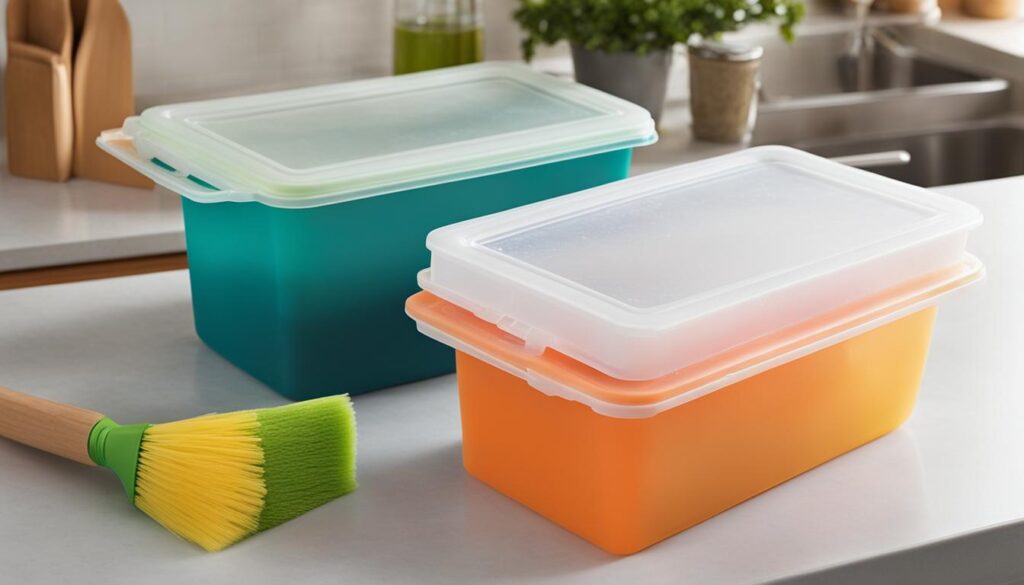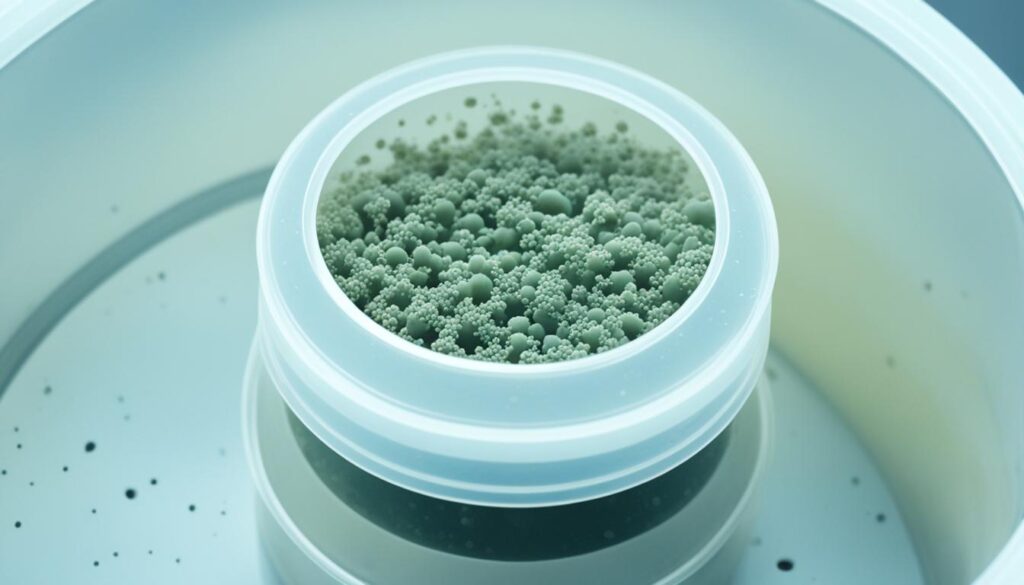
How Remove Mold from Plastic – Effective Tips & Tricks
Discovering mold on plastic surfaces can be a frustrating experience. Whether it’s on household items, furniture, or other plastic materials, mold not only looks unsightly but can also pose potential health risks. Fortunately, there are numerous techniques you can employ to remove mold from plastic and prevent its reappearance.
In this article, we will explore effective tips and tricks for removing mold from plastic. We will cover various do-it-yourself techniques that can easily be carried out at home. Additionally, we will share preventive measures to help you keep your plastic surfaces mold-free.
Key Takeaways:
- Regularly inspect your plastic items for mold growth.
- Apply a mixture of vinegar and water to remove mold stains.
- Use a scrub brush or sponge to clean the affected areas.
- Allow the plastic to dry thoroughly to prevent mold recurrence.
- Store plastic items in well-ventilated areas to minimize moisture retention.
DIY Mold Removal Techniques for Plastic
When it comes to removing mold from plastic, there are several do-it-yourself techniques that can effectively eliminate the problem. Whether you’re dealing with mold on household items, furniture, or other plastic surfaces, these methods can help you restore them to their original mold-free condition. From natural remedies to specialized mold cleaning products, here are some step-by-step instructions on how to tackle mold on plastic surfaces.
1. Natural Mold Cleaning Solutions
One of the simplest and cost-effective ways to remove mold from plastic is by using natural cleaning solutions that you can easily find at home. Vinegar, hydrogen peroxide, or a mixture of baking soda and water can be effective in eliminating mold. Simply apply the solution to the affected area, scrub gently, and let it sit for a few minutes. Then, rinse off with water and dry thoroughly.
2. Mold Cleaning Products
If the mold infestation is more severe, you may need to use specialized mold cleaning products. Look for mold removal sprays or mold stain removers specifically designed for plastic surfaces. Follow the instructions on the product label for best results. Remember to wear protective gloves and ensure proper ventilation when using these products.
3. Scrubbing and Brushing
In addition to using cleaning solutions, scrubbing and brushing the moldy plastic surface can help loosen and remove the mold. Use a soft-bristle brush or sponge to gently scrub the affected area in circular motions. Be thorough yet gentle to avoid damaging the plastic surface. Rinse thoroughly and dry completely after scrubbing.
4. Prevention and Maintenance
It’s important to remember that preventing mold growth is key to keeping your plastic items clean and mold-free. Regular maintenance is essential in preventing mold from reoccurring. Keep plastic items dry, especially in areas with high humidity. Clean and dry them promptly if they come in contact with water or moisture. Additionally, proper ventilation can help reduce humidity levels and discourage mold growth.
By following these DIY mold removal techniques for plastic, you can effectively eradicate mold from your plastic items and surfaces. Remember to prioritize prevention and maintenance to minimize the likelihood of mold returning. With these simple yet effective steps, you can restore the cleanliness and safety of your plastic belongings.

| Product Name | Features | Price | Rating |
|---|---|---|---|
| Mold Remover X | Effectively removes mold stains, Safe for plastic surfaces, Quick acting formula | $9.99 | 4.5/5 |
| Mold Fighter Y | Powerful mold and mildew cleaner, Works on various surfaces, Long-lasting results | $12.99 | 4/5 |
| Plastic Mold Cleaning Solution Z | Gentle yet effective on plastic, Eco-friendly formula, Removes mold and prevents regrowth | $7.99 | 4.8/5 |
Preventing Mold Growth on Plastic
Mold prevention is crucial for keeping your plastic items free from mold. By following these tips and suggestions, you can minimize the chances of mold developing on plastic surfaces and ensure the longevity of your plastic items.
Proper Cleaning and Maintenance
The first step in preventing mold growth on plastic is to establish a regular cleaning and maintenance routine. Here are some important steps to follow:
- Regularly clean: Wipe down plastic surfaces with a mild soap and water solution to remove any dirt or grime that may contribute to mold growth.
- Dry thoroughly: After cleaning, make sure to dry the plastic completely. Moisture is a primary factor that promotes mold growth, so eliminating excess moisture is essential.
- Inspect for damage: Regularly inspect your plastic items for any cracks, leaks, or damage that could allow moisture to seep in. Repair or replace damaged plastic to prevent mold from taking hold.
Proper Storage
How you store your plastic items can also play a significant role in preventing mold growth. Follow these storage tips:
- Avoid enclosed spaces: When storing plastic items, ensure they are not stored in tightly sealed boxes or containers, as this can create a humid environment that encourages mold growth. Opt for well-ventilated storage areas.
- Use moisture absorbers: Place moisture-absorbing products, such as silica gel packets or moisture control devices, near your stored plastic items to keep the surrounding air dry and minimize mold growth.
- Regularly check stored items: Periodically inspect your stored plastic items for any signs of mold. If you detect mold, take immediate action to remove it and address the underlying cause.
| Prevention Method | Description |
|---|---|
| Regular cleaning and drying | Regularly clean plastic surfaces and ensure they are completely dry to prevent mold growth. |
| Inspect for damage | Regularly check for cracks, leaks, or damage in plastic items, and repair or replace them to prevent moisture accumulation. |
| Avoid enclosed spaces | Store plastic items in well-ventilated areas to prevent the buildup of moisture and mold growth. |
| Use moisture absorbers | Place moisture-absorbing products near stored plastic items to keep the air dry and discourage mold growth. |
| Regularly check stored items | Periodically inspect stored plastic items for mold and address any issues immediately. |
By diligently following these prevention techniques, you can keep your plastic items mold-free and ensure their long-lasting quality.

“Preventing mold growth on plastic surfaces is a proactive approach to maintaining the cleanliness and longevity of your plastic items.” – [Insert Expert Name], Mold Prevention Specialist
Conclusion
In conclusion, by following the tips and techniques outlined in this guide, you can effectively remove mold from plastic and ensure that your items stay mold-free. Regular maintenance and proper preventive measures will go a long way in keeping your plastic surfaces clean and safe.
By implementing DIY mold removal techniques for plastic, you can easily get rid of mold using cost-effective methods that can be done at home. From using natural remedies to specialized cleaning products, these techniques will help you restore your plastic items to their original condition.
Preventing mold growth on plastic is crucial to maintaining a mold-free environment. By practicing proper cleaning and maintenance, such as regular dusting and wiping down plastic surfaces, you can reduce the chances of mold developing. Additionally, correctly storing plastic items, especially in dry and well-ventilated areas, will further prevent mold growth.
Remember, mold removal isn’t a one-time task. It requires consistent effort and attention to keep your plastic items free from mold. By following the tips outlined in this guide, you can ensure a mold-free environment and prolong the lifespan of your plastic possessions.




